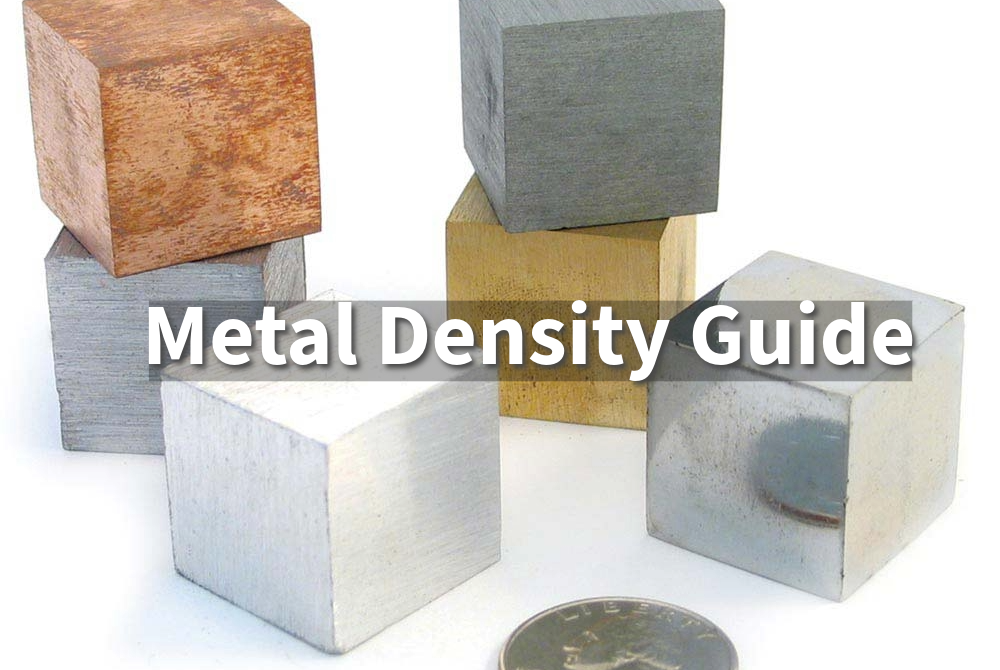Metal Density Guide: How It Impacts Strength, Weight, and Use

Explore the importance of metal density in manufacturing. Compare densities of common metals and understand their influence on performance and cost.
Introduction
Understanding metal density is essential for anyone involved in 3D printing, manufacturing, or engineering. Density affects the strength, weight, and functionality of metal parts and products. In this blog, we will discuss why metal density matters and how it can impact your decisions in 3D printing and manufacturing.
What is Metal Density?
Metal density is the mass of a metal in a given volume, usually measured in grams per cubic centimeter (g/cm³) or kilograms per cubic meter (kg/m³). It is influenced by the metal's atomic structure and how its atoms are arranged
Understanding Common Metal Densities
Metal | Density (g/cm³) |
|---|---|
Steel | 7.75-8.05 |
Aluminum | 2.70 |
Copper | 8.96 |
Titanium | 4.50 |
Lead | 11.34 |
Nickel | 8.90 |
Zinc | 7.14 |
Magnesium | 1.74 |
Platinum | 21.45 |
Tungsten | 19.25 |
Common Metals and Their Densities
Steel
Steel is a widely used alloy made mostly of iron, with a density between 7.75 and 8.05 g/cm³. Its higher density compared to lighter metals like aluminum makes it ideal for strong, durable applications such as construction, transportation, and machinery.
Aluminum
Aluminum is a lightweight metal with a density of 2.70 g/cm³, about one-third that of steel. Its low weight makes it valuable in industries like aerospace, automotive, and electronics, where reducing weight improves efficiency and performance.
Copper
Copper is a dense metal with a density of 8.96 g/cm³, making it excellent for electrical and thermal conductivity. It’s widely used in wires, motors, and transformers.
Titanium
Titanium has a moderate density of 4.50 g/cm³, about 60% of steel’s density. It’s known for its strong strength-to-weight ratio, making it ideal for lightweight, durable products in aerospace, medical, and sports industries.
Lead
Lead is a very dense metal with a density of 11.34 g/cm³. Its high density makes it useful for radiation shielding in nuclear facilities, medical devices, and certain electronics.
Nickel
Nickel, with a density of 8.90 g/cm³, is used for its corrosion resistance and ability to withstand high temperatures. It’s a key component in stainless steel and superalloys for aerospace and marine applications.
Zinc
Zinc has a density of 7.14 g/cm³ and is mainly used to coat steel to prevent rusting. It’s also used in die-casting for automotive parts and appliances.
Magnesium
Magnesium is one of the lightest structural metals, with a density of 1.74 g/cm³. Its strength-to-weight ratio makes it ideal for reducing weight in automotive, aerospace, and electronics industries.
Platinum
Platinum is a dense and valuable metal with a density of 21.45 g/cm³. It’s resistant to corrosion and is used in catalytic converters, electronics, medical devices, and jewelry.
Tungsten
Tungsten, with a density of 19.25 g/cm³, is one of the densest metals. It has a very high melting point and is used in high-temperature applications like rocket engines and electrical contacts.

What is Metal Density?
Definition and Formula
Metal density is the mass of a metal in a specific volume, essentially measuring how heavy a metal is for a given space. The formula for density is:
Density = Mass / Volume
For example, if a piece of aluminum weighs 10 grams and has a volume of 3.7 cubic centimeters, its density is:
Density = 10 grams / 3.7 cubic centimeters = 2.70 grams per cubic centimeter (g/cm³)
Units of Measurement
Density is usually measured in two main units:
Kilograms per cubic meter (kg/m³)
Grams per cubic centimeter (g/cm³)
Using consistent units is crucial when comparing the densities of different metals. For instance, to compare aluminum (2.70 g/cm³) with steel (7.85 g/cm³), both should be expressed in the same unit (g/cm³).
How Density Is Measured
There are several common methods to measure metal density:
Archimedes' Principle: This method involves placing the metal sample in water and measuring the volume of water displaced, which equals the volume of the sample. The mass of the sample is divided by this volume to find the density.

Archimedes' Principle
Source: britannica.com/Pycnometers: These are specialized containers with a known volume used to accurately measure the mass of a metal sample and calculate its density.

Pycnometer Gay Lussacvolume 10 ml
Source: auxilab.es/Precision Scales: High-accuracy scales measure the mass of a metal sample, while its volume can be determined by other means to calculate the density.

Source: eu.waagenet.de/
Why is Metal Density Important?
Impact on Strength and Durability
Metal density is linked to tensile strength, which measures how much force a material can withstand before breaking. Denser metals often have higher tensile strength, making them more durable because their atoms are tightly packed, forming stronger bonds.
However, this also means that denser metals like steel or titanium are heavier than lighter metals like aluminum. Balancing strength and weight is crucial in many engineering applications.
Influence on Weight and Efficiency
The density of a metal affects the overall weight of a component or structure. Lightweight metals like aluminum are preferred in industries like aerospace and automotive, where reducing weight enhances energy efficiency and portability.
In contrast, heavier metals may be necessary for applications where strength and durability are more important, such as heavy machinery or construction.
Role in Machining and Fabrication
Metal density also influences how easy or costly it is to machine and fabricate materials. Denser metals, like stainless steel or titanium, require more energy, specialized tools, and longer processing times to shape.
The hardness of denser metals can lead to increased tool wear and higher manufacturing costs. Knowing a material’s density is essential for estimating production costs and planning effective manufacturing processes.
Factors That Affect Metal Density
Atomic Structure and Elemental Composition
Metal density is mainly determined by its atomic structure and the types of elements in its composition. Metals with heavier atoms, like gold or tungsten, generally have higher densities than those with lighter atoms, such as aluminum or magnesium.
The arrangement of atoms also matters. Metals with a tightly packed atomic structure tend to be denser than those with a looser arrangement. Additionally, the density of an alloy (a mix of two or more metals) can differ from its pure metal components.
The addition of alloying elements can either increase or decrease the overall density based on their specific characteristics.
Temperature and Pressure
Temperature and pressure can influence metal density as well. When temperature rises, most metals expand, causing their atoms to spread out, which decreases density. On the other hand, increasing pressure compresses the atoms, resulting in higher density.
These factors are particularly important in specialized environments, like underwater or aerospace applications, where pressure changes can significantly affect metal performance.
Impurities and Alloying Elements
Impurities (unintended elements) and alloying elements (intentionally added metals) can impact density. Impurities may either raise or lower density, depending on their atomic mass. Alloying can change a metal’s density, too.
For example, adding nickel to iron to create stainless steel increases density, while adding aluminum to copper to make bronze decreases it.
How Metal Density Affects Different Industries
Aerospace Industry
In aerospace, metal density is critical. Lightweight metals like aluminum and titanium are preferred because they reduce the weight of aircraft and spacecraft, enhancing fuel efficiency and performance. Even slight changes in material density can significantly impact the design and operation of aerospace vehicles.
Automotive Industry
The automotive sector also values metal density. Manufacturers use a mix of high-density metals like steel for strong, structural parts and low-density metals like aluminum for body panels. This balance optimizes vehicle weight, fuel efficiency, and handling.
Construction
In construction, metal density is essential for structural integrity and load-bearing capabilities. High-density metals like steel and cast iron are used for beams and columns due to their strength, ensuring that buildings can withstand various forces over time.
Electronics
In the electronics industry, metal density affects the design and performance of conductive components. Denser metals, like copper, are preferred for their efficiency in transferring electrical signals and dissipating heat.
The density of metals can impact the size, weight, and efficiency of electronic devices, making it a crucial consideration in product design.
Comparing Metal Densities: Light vs. Heavy Metals
Light Metals
Light metals have a relatively low density, typically less than 5 g/cm³. Common examples include aluminum (2.70 g/cm³) and magnesium (1.74 g/cm³).
These metals are favored in applications where weight is critical, such as in aerospace and automotive industries. Their low density allows for lightweight, portable, and fuel-efficient products.

Source:lightmetals.in
Heavy Metals
Heavy metals have a higher density, usually greater than 5 g/cm³. Examples include lead (11.34 g/cm³), gold (19.30 g/cm³), and tungsten (19.25 g/cm³). These metals are used in applications requiring strength, durability, or specific properties like radiation shielding.
While heavy metals may not be suitable for weight-sensitive applications, their density is advantageous in construction, machinery, or medical devices.

Source: wikipedia.org
Conclusion
In this blog, we have explored the importance of understanding metal density and how it impacts various industries and applications. Metal density is a fundamental property that determines a material's strength, weight, and overall usefulness.
By understanding the principles of metal density, you can make informed decisions when choosing materials for your 3D printing, manufacturing, and engineering endeavors, ensuring optimal performance, efficiency, and cost-effectiveness.
Optimize Your Next Project With AutofabX
At AutofabX, we understand how critical material selection is to achieving optimal performance.
AutofabX's all-inclusive manufacturing support empowers you to focus fully on innovation and time-to-market goals. Whether you need metal 3D printing, CNC machining, composite molding, electronics assembly or packaging, we have the skills and facilities to handle every step.
Get a quote now or contact us to discuss your needs!